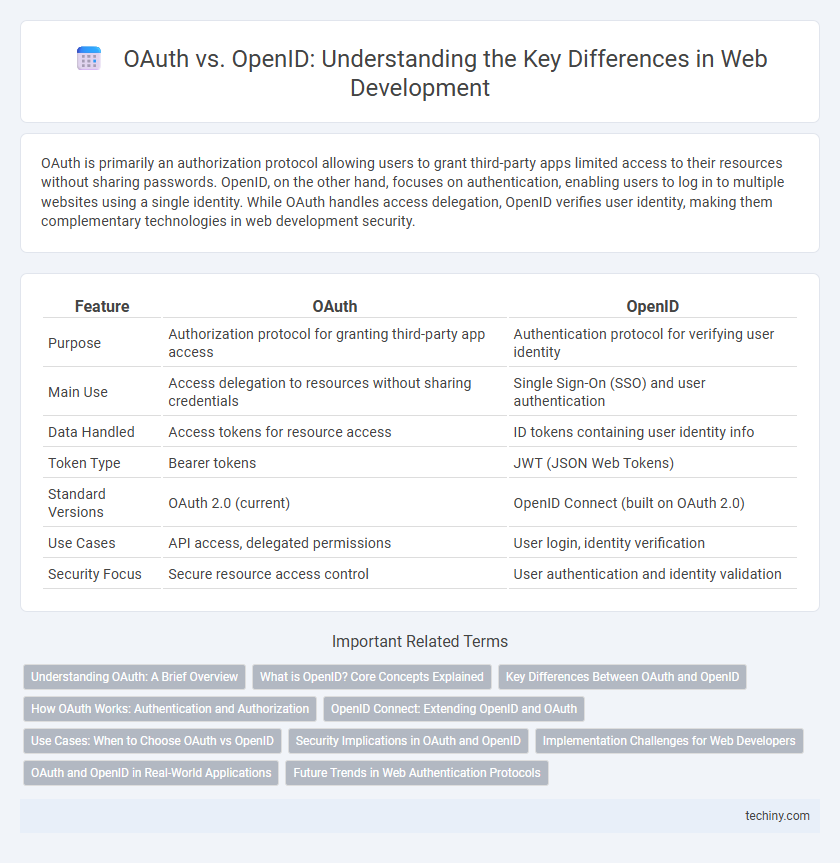OAuth is primarily an authorization protocol allowing users to grant third-party apps limited access to their resources without sharing passwords. OpenID, on the other hand, focuses on authentication, enabling users to log in to multiple websites using a single identity. While OAuth handles access delegation, OpenID verifies user identity, making them complementary technologies in web development security.
Table of Comparison
| Feature | OAuth | OpenID |
|---|---|---|
| Purpose | Authorization protocol for granting third-party app access | Authentication protocol for verifying user identity |
| Main Use | Access delegation to resources without sharing credentials | Single Sign-On (SSO) and user authentication |
| Data Handled | Access tokens for resource access | ID tokens containing user identity info |
| Token Type | Bearer tokens | JWT (JSON Web Tokens) |
| Standard Versions | OAuth 2.0 (current) | OpenID Connect (built on OAuth 2.0) |
| Use Cases | API access, delegated permissions | User login, identity verification |
| Security Focus | Secure resource access control | User authentication and identity validation |
Understanding OAuth: A Brief Overview
OAuth is an open standard for access delegation commonly used to grant websites or applications limited access to user information without exposing credentials. It enables third-party services to exchange tokens that represent user authorization scopes rather than sharing passwords, enhancing security in web development. Developers implement OAuth primarily for granting secure access to APIs, simplifying authentication workflows while protecting user data.
What is OpenID? Core Concepts Explained
OpenID is a decentralized authentication protocol that enables users to log in to multiple websites using a single set of credentials, simplifying identity management across platforms. It works by allowing an identity provider to verify a user's identity and share authentication tokens with relying parties, enhancing security and user experience. Core concepts include decentralized authentication, identity providers, relying parties, and secure token exchange for seamless and secure user access.
Key Differences Between OAuth and OpenID
OAuth is an authorization framework designed to grant third-party applications limited access to user resources without exposing credentials, primarily focusing on resource access delegation. OpenID is an authentication protocol that allows users to verify their identity across multiple websites using a single set of login credentials, emphasizing user authentication and Single Sign-On (SSO). While OAuth manages permissions and data sharing, OpenID ensures user identity verification, making their roles complementary yet distinctly different in web development security.
How OAuth Works: Authentication and Authorization
OAuth functions as an authorization framework that enables third-party applications to obtain limited access to user resources without sharing credentials. It uses access tokens granted by an authorization server after user consent to securely access protected APIs. The separation between authentication and authorization ensures OAuth focuses on resource access delegation, not user identity verification.
OpenID Connect: Extending OpenID and OAuth
OpenID Connect extends OAuth 2.0 by adding an identity layer that enables secure user authentication alongside authorization, combining the strengths of both protocols. It allows applications to verify user identity by obtaining basic profile information through standardized ID tokens, simplifying single sign-on and improving user experience. By leveraging OAuth's authorization framework, OpenID Connect supports seamless access delegation while ensuring robust identity verification for modern web applications.
Use Cases: When to Choose OAuth vs OpenID
OAuth is ideal for authorization scenarios where applications require controlled access to user resources without exposing credentials, such as third-party apps accessing API data. OpenID Connect excels in authentication by enabling single sign-on solutions that verify user identity across multiple platforms using a standardized identity layer. Choose OAuth when managing resource permissions, and OpenID Connect when confirming user identities is critical for secure access.
Security Implications in OAuth and OpenID
OAuth primarily handles authorization by granting third-party applications limited access to user resources without exposing credentials, reducing the risk of password theft but requiring robust token management to prevent misuse or replay attacks. OpenID Connect builds on OAuth by adding an identity layer that securely authenticates users through ID tokens, improving user verification while relying on OAuth's token exchange mechanisms. Both protocols necessitate proper implementation of HTTPS, token expiration, and token validation to mitigate common security threats such as token interception, replay attacks, and token forgery.
Implementation Challenges for Web Developers
Implementing OAuth presents challenges such as managing token security, handling token expiration, and ensuring proper authorization flows to protect user data. OpenID adds complexity by requiring robust identity verification, session management, and integration with diverse identity providers. Web developers must carefully configure and maintain these protocols to prevent security vulnerabilities and ensure seamless user authentication experiences.
OAuth and OpenID in Real-World Applications
OAuth is primarily used for authorization, enabling third-party applications to access resources on behalf of a user without sharing credentials. OpenID focuses on authentication, allowing users to verify their identity across different websites securely. In real-world applications, OAuth powers services like Google Drive API access, while OpenID Connect enhances single sign-on (SSO) experiences across platforms such as Microsoft Azure AD and Google Identity.
Future Trends in Web Authentication Protocols
OAuth and OpenID Connect are evolving toward more seamless and secure authentication experiences, leveraging decentralized identity and blockchain integration to enhance user control and privacy. Biometric authentication combined with these protocols is becoming prevalent, enabling passwordless login methods that reduce reliance on traditional credentials. Emerging standards focus on improving interoperability across devices and platforms, ensuring scalable and user-friendly authentication for diverse web applications.
OAuth vs OpenID Infographic

 techiny.com
techiny.com